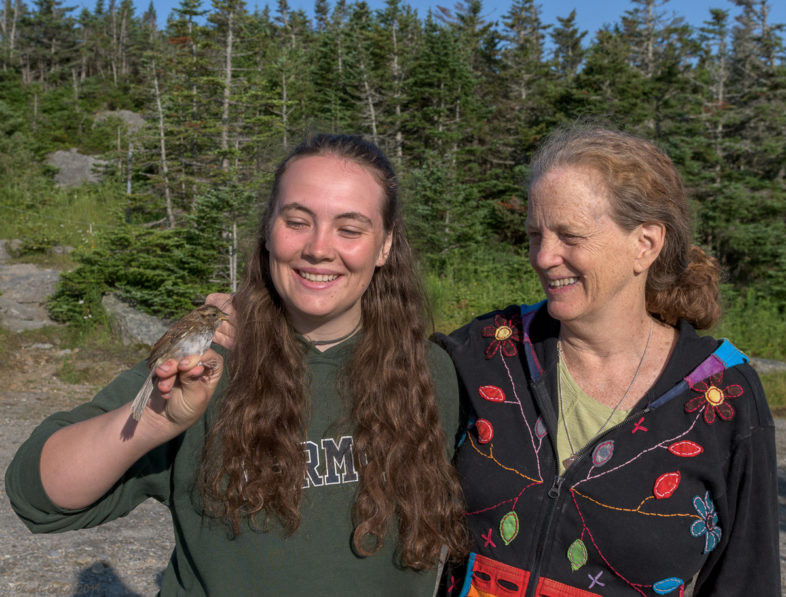
VCE 2019 Alexander Dickey intern Rose West and Landon Hall (Alexander’s mother) admire a banded White-throated Sparrow prior to release. Mt. Mansfield, 1 August 2019. © Charles Gangas
Noticeably shorter days, a near absence of bird song, heavily molting adults, and the appearance of post-breeding wanderers last week signaled seasonal changes underway on Mt. Mansfield. VCE’s penultimate banding session on the ridgeline coincided with the calendar’s turn from July to August, and the winding down of our field season. As has been the case since our first visit in early June, avian activity was slow, unexpectedly so. We knew the airwaves would be quiet, but we anticipated a good showing of independent fledglings and dispersing adults, with perhaps an early migrant or two in the mix. Our catch was again underwhelming.
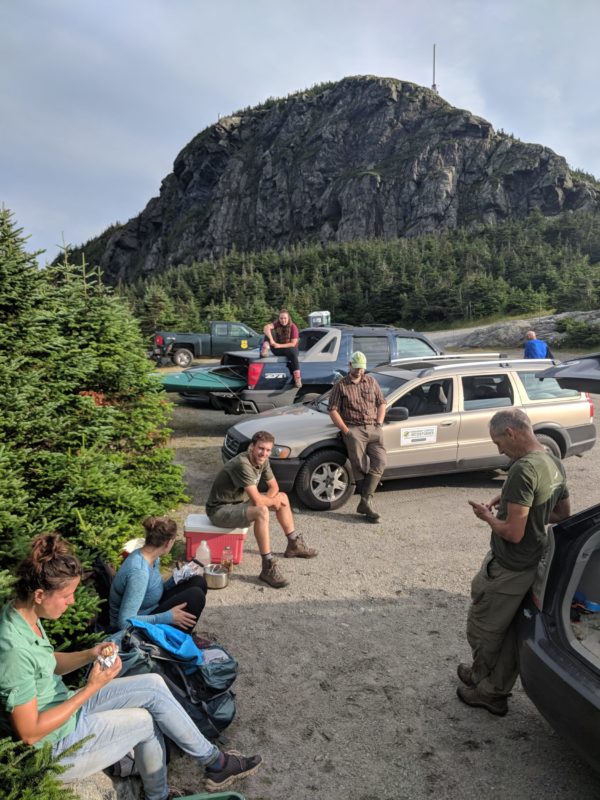
The VCE Mansfield banding crew had ample time to hang out on 1 August, chatting, checking smartphones, snacking, and waiting for the big net run that never materialized. © Nathaniel Sharp
Despite more “down time” than usual (or desired) at the VCE banding station, we managed to catch enough birds—29 in all—including a few out-of-the-ordinary species (Yellow-bellied Flycatcher, Cedar Waxwing, Ovenbird), to keep enthusiasm high. With near-ideal weather (warm, calm, some cloud cover), we kept expecting a big net run, though it never materialized. My hourly refrain of “Bring back a Tennessee Warbler!” went unfulfilled. Captures of Bicknell’s Thrush took a dramatic nosedive, with only 2 adult males, both previously banded birds that appeared in our nets for the first time this season. One of these was among our oldest on record, banded as a 2+ year-old on 12 July 2012, and so at least 9 years old—the granddaddy of all time was an 11 year-old male on Stratton Mountain.
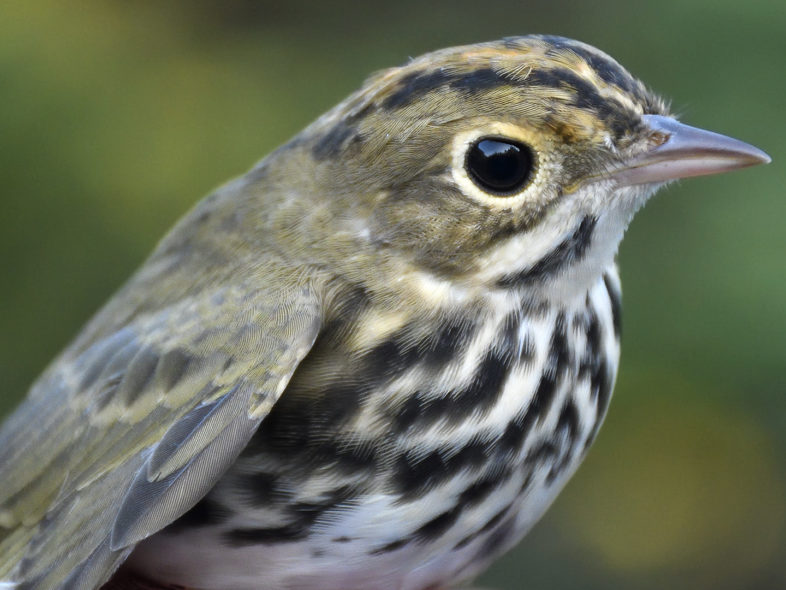
A sure sign of the changing season, an immature Ovenbird in VCE’s Mansfield nets on 1 August was a post-breeding wanderer from the hardwood forests below. © Michael Sargent
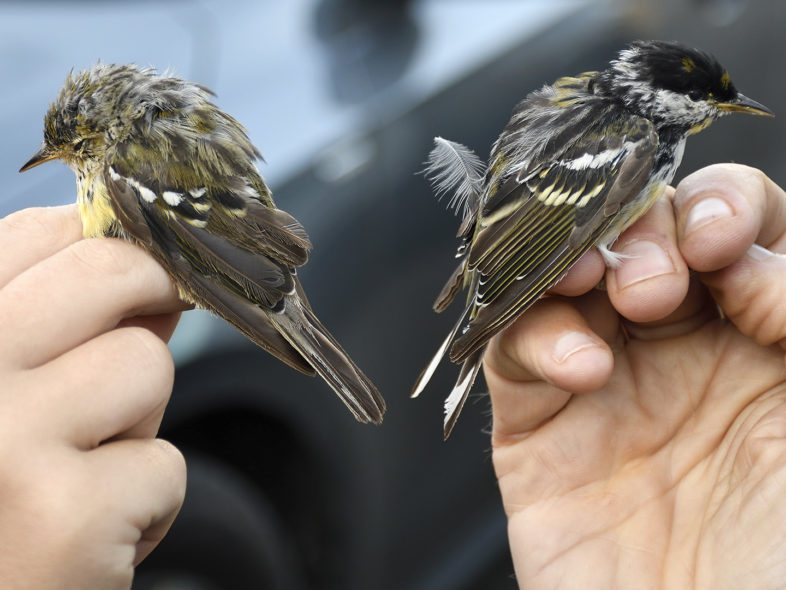
Heavily-molting female (left) and male (right) Blackpoll Warblers, showing mixed generations of feathers from breeding (alternate) and non-breeding (basic) plumages. 1 August 2019. © Charles Gangas
Our two-day capture total included:
Yellow-bellied Flycatcher — 1 hatching-year (HY) bird
Winter Wren — 3 free-flying HY birds
Bicknell’s Thrush — 2: first 2019 captures of a male banded in 2012 (at least 9 years old) and a male banded in June 2018
Hermit Thrush — 3 free-flying birds in juvenal plumage
Cedar Waxwing — 2: pair captured together; female with regressing brood patch
Dark-eyed Junco (Slate-colored) — 4: free-flying juvenile and 3 within-season adult recaptures
White-throated Sparrow — 4 new bandings: 2 free-flying juveniles, adult male and female
Ovenbird — 1 HY bird
Blackpoll Warbler — 6: 3 free-flying juveniles, 2 new females, within-season male recapture; all 3 adults in heavy flight feather molt
Yellow-rumped Warbler (Myrtle) — 3: free-flying juvenile, first 2019 capture of male banded in July 2018, within-season female recapture
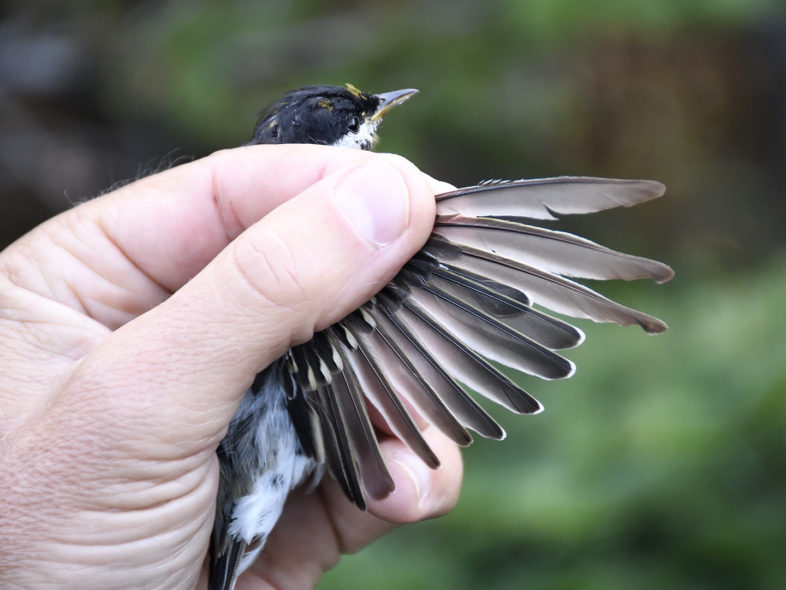
An adult male Blackpoll Warbler in heavy wing molt. The 9 nine primaries molt sequentially and distally (away from the body), while replacement of the six secondaries begins later and proceeds proximally (towards the body). On this bird, note its three faded and worn outer primaries (#7–9), a small gap where primary #6 (fourth from outside ) is missing, its 2/3-grown primary #5, and fresh and darker primaries #4 (nearly full length) through #1 (the innermost and first to molt). Only 5 of its six secondaries remain, indicating that #1 recently dropped. This bird’s entire molt will last 35-40 days, after which it will begin fattening for an epic, non-stop transoceanic migration to South America, aided by a new complement of feathers. Mt. Mansfield, 1 August 2019. © Michael Sargent
The leisurely-paced influx of netted birds allowed our visitors some memorable, up-close encounters. We were pleased to have Ty Christensen return with his grandfather Harry for a third consecutive summer, and it was a treat to have our 2019 Alexander Dickey Conservation Intern Rose West spend time with Alex’s mother Landon Hall, who has played an instrumental role in establishing and perpetuating VCE’s annual summer internship. As always, mentoring and inspiring the next generation of conservationists is a top priority for VCE, and immensely rewarding for us.
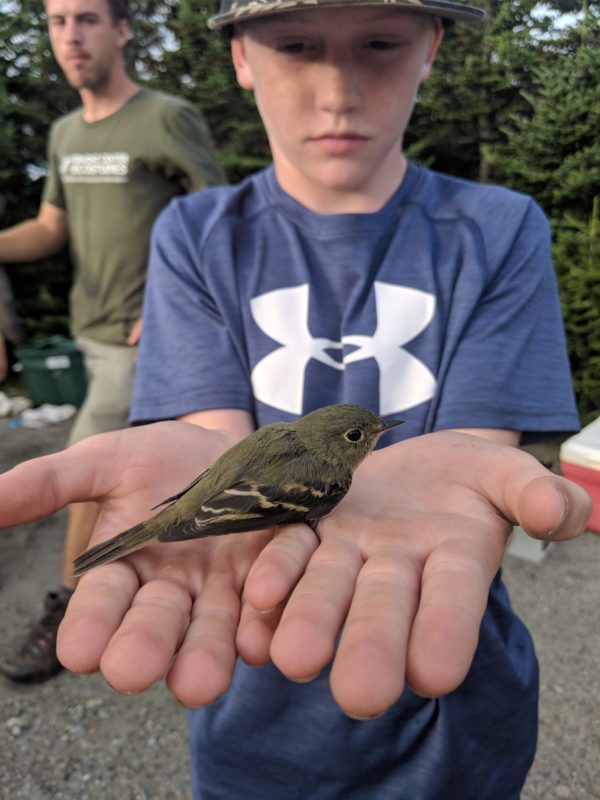
Upcoming generations of bird conservationists: Spencer Hardy (background) watches as Ty Christensen releases a banded Yellow-bellied Flycatcher. © Nathaniel Sharp
Finally, a bit of humor prevailed when we caught our last bird of the day—a male Bicknell’s Thrush with an unusual coiffure. For whatever reason(s), the bird had lost feathers from the back of its head, leaving a patch that resembled (at least in some people’s minds) the tonsure of a certain VCE biologist who happened to be present. This coincidence demanded that a side-by-side photo be taken, and both subjects obliged.
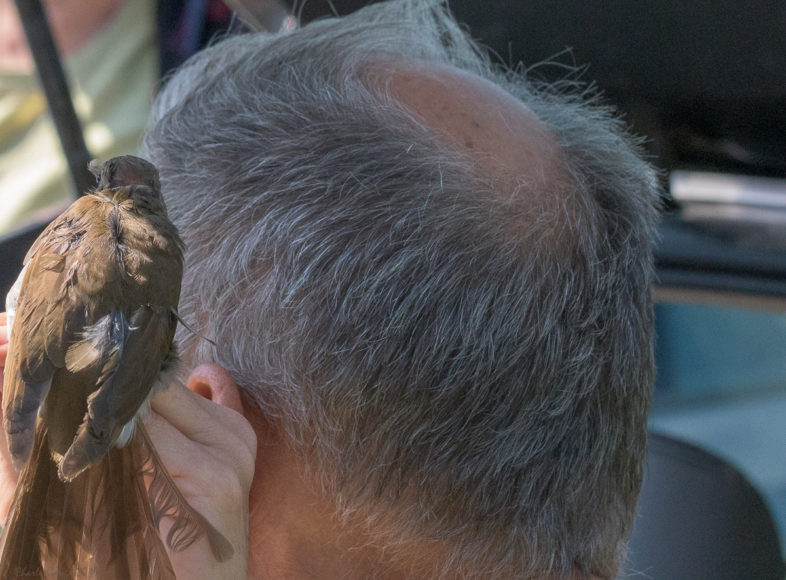
Side-by-side avian and human tonsures: a Bicknell’s Thrush with aberrant unfeathered patch on rear of its head and an anonymous VCE biologist with a similar but decades-old bare patch. © Charles Gangas.
With yesterday’s rain-out of our planned final summer visit, we may sneak in one more banding session next week. By that time, we’ll expect even more non-local birds, including perhaps the Tennessee Warbler that has eluded us so far.

As usual an interesting and fun report. I especially appreciate the break down info on the feather molt. Maybe you need to switch to monarch watching/banding.